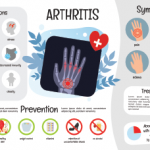Although arthritis and rheumatism are more common among people older than 65, more people who are younger than 65 actually have arthritis, so the condition has big effects on work. According to the National Health Interview Survey, the most common causes of work disability are back or neck problems, which account for 30%; depression and anxiety, accounting for 21%; and arthritis and rheumatism, accounting for 19%. Making matters worse, arthritis is frequently seen alongside other chronic conditions: From 2013–15, the survey found 49% of those with heart disease also had arthritis, as did 47% of diabetes patients and 31% of obese people.
“In all three of these diseases, physical activity is the recommended management, so if you’re not being physically active, you’re not getting the proper management for your diseases,” Dr. Helmick said. “And the people who have these diseases plus arthritis are much less physically active than those who have the disease and don’t have arthritis. So arthritis is really a specific barrier to being physically active.”
Researchers have also found that people with arthritis report 10 of the previous 30 days as “unhealthy” days, either physically or mentally, compared with 4.8 of the previous 30 for those without arthritis.5
Interventions from a public health perspective include not only physical activity, but education on how to self-manage, and research into prevention to strengthen the scientific basis for community interventions, Dr. Helmick said. Continued funding for state and national programs is needed to raise visibility and make inventions more available because people are more likely to participate in settings in the community than in typical clinical settings, he said.
Arthritis Awareness Campaigns
From 1999’s National Arthritis Action Plan to the National Public Health Agenda for Lupus: A Blueprint for Action in 2015 to its appearance in the CDC’s high-visibility Vital Signs reports and articles in the Morbidity and Mortality Weekly Report, arthritis awareness has been promoted by the CDC and other federal agencies.
The Healthy People 2020 campaign—among other goals—attempts to “attain high-quality, longer lives free of preventable disease, disability, injury and premature death.” The campaign includes several arthritis objectives, including the reduction of pain, activity limitations and employment issues. And the 2030 campaign also includes objectives regarding arthritis.
Benefiting from Increased Attention to Pain Issues
Dr. Helmick also discussed how increased attention to generic pain issues and the opioid crisis may help raise the profile of arthritis as a public health threat. Such organizations as the Institute of Medicine, the U.S. Department of Health & Human Services and the White House have also made pain a primary focus, largely with the goal of reducing addiction to opioids. Pain reduction is a goal that is closely aligned with rheumatic disease treatment and awareness, Dr. Helmick said.



